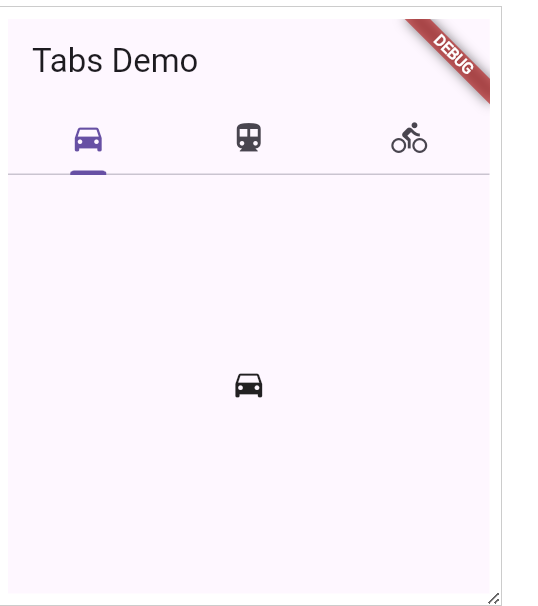目录:
-
- 1、flutter路由和导航简介
- 2、路由的使用
-
- [2.1、使用 Navigator](#2.1、使用 Navigator)
- 2.2、使用命名路由
- 2.3、使用路由器
- 3、应用中添加Tab导航
- 4、页面跳转一个新页面和回退
- 5、传递数据到新页面
- [6、使用 RouteSettings 传递参数](#6、使用 RouteSettings 传递参数)
1、flutter路由和导航简介
Flutter 提供了一个完整的系统,用于在屏幕之间导航和处理 深层链接。没有复杂深度链接的小型应用程序可以使用 Navigator,而具有特定深度链接和导航的应用程序 要求还应该使用 Router 来正确处理 Android 和 iOS,并在应用程序运行时与地址栏保持同步 在 Web 上运行。
2、路由的使用
2.1、使用 Navigator
小组件使用正确的过渡将屏幕显示为堆栈 动画。要导航到新屏幕,请通过 route 访问 并调用命令式方法。
dart
child: const Text('Open second screen'),
onPressed: () {
Navigator.of(context).push(
MaterialPageRoute(builder: (context) => const SecondScreen()),
);
},因为会保留一堆对象(表示历史记录 stack),该方法还接受一个 object。
2.2、使用命名路由
dart
child: const Text('Open second screen'),
onPressed: () {
Navigator.pushNamed(context, '/second');
},/second表示在列表中声明的命名路由。有关完整示例,请按照 Flutter 说明书中的使用命名路由导航 recipe 进行作。MaterialApp.routes
局限性:
- 尽管命名路由可以处理深度链接,但行为始终相同,并且 无法自定义。当平台收到新的深度链接时,Flutter 将新用户推送到Navigator 上,而不管用户当前位于何处。
- Flutter 也不支持使用 命名路由。由于这些原因,我们不建议在大多数 应用。
2.3、使用路由器
具有高级导航和路由要求(例如 使用指向每个屏幕的直接链接的 Web 应用程序,或具有多个小组件的应用程序)应使用路由包,例如 go_router 解析路由路径并配置每当应用程序收到 new deep link 的 intent 值。
要使用 Router,请切换到 or 上的构造函数,并为其提供一个配置。路由包, 如 go_router,通常提供路由配置和路由 可以按如下方式使用:
dart
child: const Text('Open second screen'),
onPressed: () => context.go('/second'),因为像 go_router 这样的包是声明性的,所以它们将始终显示 收到深度链接时的相同屏幕。
go_router的使用案例:

dart
dependencies:
flutter:
sdk: flutter
go_router: ^x.y.z # 替换x.y.z为最新版本号
dart
import 'package:flutter/material.dart';
import 'package:go_router/go_router.dart';
void main() {
runApp(MyApp());
}
class MyApp extends StatelessWidget {
@override
Widget build(BuildContext context) {
final _router = GoRouter(
initialLocation: '/',
routes: [
GoRoute(
path: '/',
builder: (context, state) => HomePage(),
),
GoRoute(
path: '/details',
builder: (context, state) => DetailsPage(),
),
],
);
return MaterialApp.router(
routerConfig: _router,
);
}
}- 创建页面和导航
确保你已创建了相应的页面(如HomePage和DetailsPage),这些将作为路由的目标。例如:
dart
class HomePage extends StatelessWidget {
@override
Widget build(BuildContext context) {
return Scaffold(
appBar: AppBar(title: Text('Home')),
body: Center(
child: ElevatedButton(
onPressed: () {
context.go('/details'); // 使用context.go进行导航
},
child: Text('Go to Details'),
),
),
);
}
}- 使用参数和嵌套路由(可选)
你可以在路由中使用参数,并设置嵌套路由:
dart
GoRoute(
path: '/user/:id', // 参数使用冒号标记
builder: (context, state) {
final userId = state.params['id']; // 获取参数值
return UserPage(userId: userId); // 将参数传递给页面
},
routes: [ // 嵌套路由示例
GoRoute(
path: 'profile',
builder: (context, state) => ProfilePage(),
),
],
),在页面中使用参数:
dart
class UserPage extends StatelessWidget {
final String userId; // 页面接收参数构造函数或初始化列表赋值方式之一
// 构造函数接收参数userId 初始化列表赋值方式也行 如 final String userId; UserPage({Key? key, required this.userId}) : super(key: key); 然后在build中使用userId。 例如显示在文本中:Text('User ID: $userId')。 嵌套路由的使用同理,你可以在ProfilePage中通过context访问嵌套路由的参数。 例如:final profileId = state.params['profileId'];
// 在ProfilePage的build方法中使用。 注意这里的state是从context获取的,通常在build方法中通过ModalRoute.of(context).settings来获取。 但由于我们使用了GoRouter,可以直接通过builder的state参数获取。 例如在ProfilePage的build方法中可以直接使用String profileId = state.params['profileId']; 来获取参数。 若要导航到嵌套路由,可以使用context.go('/user/${userId}/profile');。 若要在嵌套路由的页面中使用非嵌套路由的参数,可以通过ModalRoute.of(context).settings.arguments来获取。 但由于我们使用了GoRouter,可以直接通过state参数获取。 若要在嵌套路由中导航,可以使用context.go('profile');(注意没有前导斜杠)。 若要在非嵌套路由中使用嵌套路由的参数,可以在非嵌套路由的页面中通过context.go('/user/${userId}'); 然后在这个路由的builder方法中通过state.subloc获取嵌套路由的状态,例如:String
UserPage({required this.userId}); 3、应用中添加Tab导航

dart
import 'package:flutter/material.dart';
void main() {
runApp(const TabBarDemo());
}
class TabBarDemo extends StatelessWidget {
const TabBarDemo({super.key});
@override
Widget build(BuildContext context) {
return MaterialApp(
home: DefaultTabController(
length: 3,
child: Scaffold(
appBar: AppBar(
bottom: const TabBar(
tabs: [
Tab(icon: Icon(Icons.directions_car)),
Tab(icon: Icon(Icons.directions_transit)),
Tab(icon: Icon(Icons.directions_bike)),
],
),
title: const Text('Tabs Demo'),
),
body: const TabBarView(
children: [
Icon(Icons.directions_car),
Icon(Icons.directions_transit),
Icon(Icons.directions_bike),
],
),
),
),
);
}
}4、页面跳转一个新页面和回退
- 用 Navigator.push() 跳转到第二个路由
- 用 Navigator.pop() 回退到第一个路由
5、传递数据到新页面


dart
import 'package:flutter/material.dart';
class Todo {
final String title;
final String description;
const Todo(this.title, this.description);
}
void main() {
runApp(
MaterialApp(
title: 'Passing Data',
home: TodosScreen(
todos: List.generate(
20,
(i) => Todo(
'Todo $i',
'A description of what needs to be done for Todo $i',
),
),
),
),
);
}
class TodosScreen extends StatelessWidget {
const TodosScreen({super.key, required this.todos});
final List<Todo> todos;
@override
Widget build(BuildContext context) {
return Scaffold(
appBar: AppBar(title: const Text('Todos')),
body: ListView.builder(
itemCount: todos.length,
itemBuilder: (context, index) {
return ListTile(
title: Text(todos[index].title),
// When a user taps the ListTile, navigate to the DetailScreen.
// Notice that you're not only creating a DetailScreen, you're
// also passing the current todo through to it.
onTap: () {
Navigator.push(
context,
MaterialPageRoute(
builder: (context) => DetailScreen(todo: todos[index]),
),
);
},
);
},
),
);
}
}
class DetailScreen extends StatelessWidget {
// In the constructor, require a Todo.
const DetailScreen({super.key, required this.todo});
// Declare a field that holds the Todo.
final Todo todo;
@override
Widget build(BuildContext context) {
// Use the Todo to create the UI.
return Scaffold(
appBar: AppBar(title: Text(todo.title)),
body: Padding(
padding: const EdgeInsets.all(16),
child: Text(todo.description),
),
);
}
}6、使用 RouteSettings 传递参数
dart
import 'package:flutter/material.dart';
class Todo {
final String title;
final String description;
const Todo(this.title, this.description);
}
void main() {
runApp(
MaterialApp(
title: 'Passing Data',
home: TodosScreen(
todos: List.generate(
20,
(i) => Todo(
'Todo $i',
'A description of what needs to be done for Todo $i',
),
),
),
),
);
}
class TodosScreen extends StatelessWidget {
const TodosScreen({super.key, required this.todos});
final List<Todo> todos;
@override
Widget build(BuildContext context) {
return Scaffold(
appBar: AppBar(title: const Text('Todos')),
body: ListView.builder(
itemCount: todos.length,
itemBuilder: (context, index) {
return ListTile(
title: Text(todos[index].title),
// When a user taps the ListTile, navigate to the DetailScreen.
// Notice that you're not only creating a DetailScreen, you're
// also passing the current todo through to it.
onTap: () {
Navigator.push(
context,
MaterialPageRoute(
builder: (context) => const DetailScreen(),
// Pass the arguments as part of the RouteSettings. The
// DetailScreen reads the arguments from these settings.
//通过此处来传递参数,其他地方同上
settings: RouteSettings(arguments: todos[index]),
),
);
},
);
},
),
);
}
}
class DetailScreen extends StatelessWidget {
const DetailScreen({super.key});
@override
Widget build(BuildContext context) {
final todo = ModalRoute.of(context)!.settings.arguments as Todo;
// Use the Todo to create the UI.
return Scaffold(
appBar: AppBar(title: Text(todo.title)),
body: Padding(
padding: const EdgeInsets.all(16),
child: Text(todo.description),
),
);
}
}